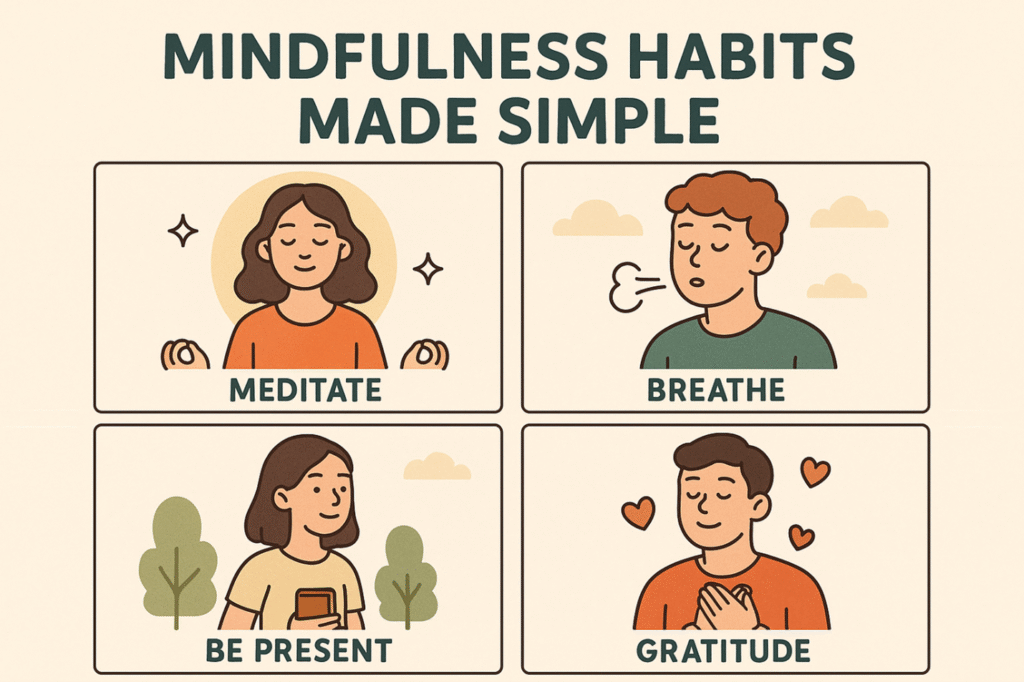Did you ever have the feeling that your head is always on a runaway train, hopping from work to your personal problems, and hardly finding a moment to take a breath? If so, you’re not alone. Stress becomes our new setting in the modern day as we get tugged so many different ways. This is why making mindfulness habits is now more significant than ever.
The good news? Mindfulness does not necessarily imply sitting with your legs crossed and being silent for an hour. Something simple, yet potent and effective, are 5-minute mindfulness habits that you can start practising. In a few minutes daily, you can lower the level of anxiety, become calmer, and even alter the brain reaction towards stress.

The Science Behind Mindfulness Habits
Mindfulness is not just a cool buzzword; it is a neuroscience-endorsed practice. Research studies reveal that regular practice of daily mindfulness can modify the brain. The brain is designed to function with regular mindfulness, which enlarges the grey matter through which memory, learning, and emotional control are facilitated.
Daily simple mindfulness exercises help in calming your brain. The stress and fear-causing part of the amygdala becomes less responsive. Meanwhile, your decision-making region (the prefrontal cortex) gets stronger. Mindfulness habits for stress relief do not merely make you feel calm at a particular moment; they also cultivate a lasting sense of calm. In the long run, they re-circuit your brain to long-lasting tranquility and stability.
5-Minute Mindfulness Habits That Actually Work
Most individuals avoid mindfulness because they feel it is Time-consuming. However, studies have shown that even brief mindfulness techniques, practised daily (for just 5 minutes), can reduce cortisol levels and improve mood.
The key is consistency. Easy mindfulness routines can be incorporated into everyday life, rather than waiting until people feel ready to start meditating at the perfect time. This does not involve complex routines; these routines can be incorporated during coffee breaks, commuting time, or even before one goes to sleep.
Now we are going to look at five effective 5-minute mindfulness habits that you can begin today in an effort to help you add some sanity and clarity to your life.
Habit 1: The 5-Minute Breathing Reset
The easiest method to get in touch with the present is through breathing. In this practice, you concentrate on your breathing alone for five minutes. Breathe considerably with your nose, then wait a moment, and then breathe fully with your mouth.
This 5-minute mindfulness habit helps calm your heart and tells your body that it is time to relax. Research suggests that it can lower blood pressure and alleviate feelings of being overwhelmed. The best part? It can be done at any place, at your desk, in your car, or under stress during an urgent meeting.
Habit 2: The Gratitude Pause
Gratitude is a form of mindfulness, as it shifts your perspective from a negative to a positive one in your life. Spend five minutes a day, list three things that you are grateful for. They do not need to be large; a good cup of coffee, a smile from a stranger, or getting something done on time makes up for it.
Not only do you experience a better mood after daily mindfulness exercises for calmness, but it also prepares your mind to see the good, having also decreased stress and made you more resilient. To get started, it is even easier when a beginner creates a gratitude journal.
Habit 3: The Mindful Walk
Walking is the thing we do daily, unconsciously. You can also turn a daily routine activity into a relaxing practice by incorporating mindfulness.
Take a period of five minutes to work on the feel of your feet on the ground, the beat of your steps and what you hear. When the mind begins to wander, take yourself back to the present. This is an easy routine that integrates movement and mindfulness, making it ideal for busy individuals who want mindfulness habits for stress relief but don’t have time to sit down.
Habit 4: The Body Scan Reset
The body scan is a powerful, simple mindfulness exercise that helps you reconnect with your body and release built-up tension. For five minutes, sit or lie down comfortably. Close your eyes and mentally scan your body from head to toe.
Pay attention to areas where you feel tightness, like your shoulders, jaw, or back. As you notice each spot, breathe deeply and imagine releasing the tension. This exercise is beneficial to do after a long day at work or before going to bed. Many beginners find this one of the most effective mindfulness habits for calmness because it quickly grounds them in the present moment.
An advanced simple mindfulness body scan will help you reconnect with your body and release the tension accumulated. Sit or lie down and take a five-minute rest. Shut your eyes and in your mind, circle your head and entire body up and down.
Monitor when you experience tightness, possibly in your shoulders, jaw, or back. With every spot you make, then you breathe in and visualise that you are releasing tension. It is an excellent practice, particularly when needed, such as after a hard workday or right before sleep. This is one of the mindfulness habits for calmness that beginners can adopt, as it helps them stay grounded in the present.
Habit 5: The 5-Minute Reflection Pause
Take five minutes to think at the close of your day. You don’t need to scroll through the phone; you should just sit down and ask yourself:
- What went well today?
- What challenged me?
- How did I respond?
This reflection of simplicity creates space for awareness and self-compassion. It also builds up over time to help you become strong in stopping rather than directly responding to stress. It also becomes easier to reflect on progress with your mindfulness habits, and mindful practices are transformed into long-term change.

How to Build Daily Mindfulness Practices
It is easy to start being mindful, but staying that way may be tougher. The following are some of the ways to make it a lasting activity in your life:
- Start Small: To achieve results, all you need to do is 5 minutes per day. Don’t put yourself through long sessions.
- Pick a Trigger: Use it with an already existing habit, such as after brushing your teeth or before your morning coffee.
- Track Your Progress: A journal or an app can help you stay consistent. Minor runs gain force.
- Be Patient: The fruits of mindfulness increase with time. Missing a day is not a failure; you simply begin again.
Consider mindfulness to be an exercise. Constant little thrusts are infinitely stronger than infrequent blistering attacks.
Mindfulness Tools and Apps to Try
Apps and guided practices can help if you are new to mindfulness. Headspace, Insight Timer, and Calm are some of the best mindfulness apps of 2025. These applications contain quick mindfulness techniques, such as guided breathing or mini-meditations, that are ideal for beginners.
Guides to mindfulness practices can be found online, and most are free on websites such as YouTube. For individuals in the workforce, a 5-minute guided meditation practice during a break can help refocus their vision and decrease stress levels throughout the day.
At Healthabulous, we often recommend combining a digital tool with offline habits. Although apps bring order, in reality, routines such as walking or journaling make mindfulness processable and sustainable in the real world.
Conclusion
Stress, anxiety, and overwhelm may feel like unavoidable parts of modern life. Yet by practising mindfulness habits, even for just five minutes a day, you can begin to rewire your brain for calm.
Whether it’s a breathing reset, a gratitude pause, a mindful walk, a body scan, or a reflection practice, these 5-minute mindfulness habits are simple enough for beginners yet powerful enough to make a real difference. The secret is consistency. Over time, these small changes transform into a calmer mind, better focus, and greater resilience.
Your brain is designed to adapt. Start with one habit today, and you’ll see how quickly mindfulness can shift your energy, your mindset, and even your relationships. For more guides on building a healthier mind and body, explore Healthabulous, your trusted resource for everyday wellness.
FAQs About Mindfulness Habits
1. Can mindfulness really change my brain?
2. Do I need a quiet space to practice mindfulness?
Not always. While silence helps, you can practice mindful breathing or walking anywhere, even during a busy day.
3. How fast can I see results from mindfulness?
Some benefits, like reduced stress, appear within days. Long-term brain changes happen after consistent practice over weeks or months.
4. Are mindfulness apps effective?
Yes, they’re great for beginners. However, combining apps with offline routines creates the strongest results.
5. What’s the easiest mindfulness habit for beginners?
Breathing exercises are the most straightforward and most accessible. Just 5 minutes of mindful breathing can instantly bring calm.


